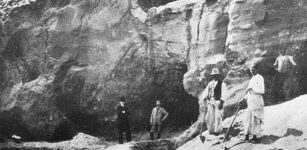On This Day In History: Thor Heyerdahl Sails From Morocco On Papyrus Boat Ra II To Barbados – On May 17, 1970
AncientPages.com - On May 17, 1970, the reed boat Ra II with Thor Heyerdahl, accompanied by an international crew, set sail from Safi in Morocco on course for Barbados.
Thor Heyerdahl in front of the raft RA11 before the second attempt to crush the Atlantic. The picture was taken in Morocco, date unknown. Photo: Michel Lipchitz/AP
With this expedition, Thor Heyerdahl (1914 – 2002) wanted to prove that one could have used this type of vessel to cross the Atlantic Ocean in ancient times.
Ra II's vessel was built of papyrus by Demetrio, Juan, and Jose Limachi from Lake Titicaca in Bolivia and based on drawings and models from Ancient Egypt.
A year earlier, Heyerdahl built a 45-foot-long copy of an ancient Egyptian papyrus vessel with the aid of traditional boat builders from Lake Chad in Central Africa.
Named after the sun god Ra, the boat was transported to Safi in Morocco, from where it set sail for the Caribbean on May 24, 1969. Defects in design and other sailing problems caused it to founder in July, 600 miles short of its goal.
It had sailed 3,000 miles and had almost made it across the Atlantic Ocean. This time, the expedition was successful.
After a voyage of 57 days and 4,000 miles, the ship arrived in Barbados. The story of this voyage is recorded in the book The Ra Expeditions (1971) and a documentary film.
Additionally, the expedition took samples of marine pollution and presented their report to the United Nations.
Thor Heyerdahl was a Norwegian adventurer and ethnographer with a zoology, botany, and geography background. He led the famous Kon-Tiki (1947) and Ra (1969–70) transoceanic scientific expeditions. Both expeditions were intended to prove the possibility of ancient transoceanic contacts between distant civilizations and cultures.
The Ra II in the Kon-Tiki Museum. Image credit: Ralf Roletschek - CC-BY-SA via source
For the most part, Heyerdahl's theories have not been accepted by anthropologists. Late in 1977, Heyerdahl and an international crew embarked upon the Tigris expedition, a four-month, 4,000-mile voyage in a craft made of reeds.
The expedition began on the Tigris River in Iraq, traveled down the Persian Gulf, across the Arabian Sea to Pakistan, and ended in the Red Sea. The goal of the Tigris expedition was to establish the possibility that the ancient Sumerians might have used similar means to spread their culture through southwest Asia and the Arabian Peninsula.
The voyage was recorded in Heyerdahl's book The Tigris Expedition (1979) and a documentary film. He subsequently led research expeditions to the Maldive Islands, Easter Island, and an archaeological site in Peru.
The Ra II is now in the Kon-Tiki Museum in Oslo, Norway.
AncientPages.com
More From Ancient Pages
-
 Jesus Christ’s Tomb Dates To Roman Emperor Constantine’s Era – Researchers Confirm
Archaeology | Dec 12, 2017
Jesus Christ’s Tomb Dates To Roman Emperor Constantine’s Era – Researchers Confirm
Archaeology | Dec 12, 2017 -
 Clay Cylinders With Oldest Known Alphabet Unearthed In Ancient Syrian City Of Umm-el Marra
Archaeology | Nov 21, 2024
Clay Cylinders With Oldest Known Alphabet Unearthed In Ancient Syrian City Of Umm-el Marra
Archaeology | Nov 21, 2024 -
 Drones Find Evidence Roman Siege Of Masada Lasted Much Shorter Than Previously Thought
Archaeology | Sep 6, 2024
Drones Find Evidence Roman Siege Of Masada Lasted Much Shorter Than Previously Thought
Archaeology | Sep 6, 2024 -
 Yokai Amabie – Protective Ancient Spirit That Can Ward Off Epidemics
Featured Stories | Mar 30, 2020
Yokai Amabie – Protective Ancient Spirit That Can Ward Off Epidemics
Featured Stories | Mar 30, 2020 -
 Shining Swords: Magical Artifacts That Symbolized Power, War, Punishment And Righteousness
Featured Stories | Nov 20, 2024
Shining Swords: Magical Artifacts That Symbolized Power, War, Punishment And Righteousness
Featured Stories | Nov 20, 2024 -
 Were Other Humans The First Victims Of The Sixth Mass Extinction?
Evolution | Nov 1, 2023
Were Other Humans The First Victims Of The Sixth Mass Extinction?
Evolution | Nov 1, 2023 -
 Ancient Petroglyphs Of Cholpon-Ata And Mysterious Balbals Figures That Guard Grave Sites, Kyrgyzstan
Featured Stories | Aug 24, 2015
Ancient Petroglyphs Of Cholpon-Ata And Mysterious Balbals Figures That Guard Grave Sites, Kyrgyzstan
Featured Stories | Aug 24, 2015 -
 Ancient Clay Seals That Could Re-Write Hittite History Discovered In Kayalıpınar, Turkey
Archaeology | Sep 14, 2023
Ancient Clay Seals That Could Re-Write Hittite History Discovered In Kayalıpınar, Turkey
Archaeology | Sep 14, 2023 -
 Strange Mummies Of Venzone: Ancient Bodies That Never Decompose Remain An Unsolved Mystery
Featured Stories | Oct 22, 2018
Strange Mummies Of Venzone: Ancient Bodies That Never Decompose Remain An Unsolved Mystery
Featured Stories | Oct 22, 2018 -
 The Black Pyramid Of Amenemhat III – Mysterious Underground Chambers And Lost Ancient Treasures
Featured Stories | Aug 9, 2021
The Black Pyramid Of Amenemhat III – Mysterious Underground Chambers And Lost Ancient Treasures
Featured Stories | Aug 9, 2021 -
 Has A Herculaneum Scroll Solved The Mystery Of Plato’s Death?
Linguistic Discoveries | May 8, 2024
Has A Herculaneum Scroll Solved The Mystery Of Plato’s Death?
Linguistic Discoveries | May 8, 2024 -
 The Red Dragon Of Wales – Ancient Symbol Dating Back To Roman Times
Ancient Symbols | Jan 3, 2018
The Red Dragon Of Wales – Ancient Symbol Dating Back To Roman Times
Ancient Symbols | Jan 3, 2018 -
 Riddle Of The Old ‘Cursed’ Car – Supernatural Forces Or Unusual Coincidences?
Featured Stories | Dec 21, 2019
Riddle Of The Old ‘Cursed’ Car – Supernatural Forces Or Unusual Coincidences?
Featured Stories | Dec 21, 2019 -
 Tetzacualco – Mesoamerican Mini Model Of The Universe Discovered Underwater
Archaeology | Jan 4, 2018
Tetzacualco – Mesoamerican Mini Model Of The Universe Discovered Underwater
Archaeology | Jan 4, 2018 -
 On This Day In History: Famous American Author Edgar Allan Poe Found Dying – On Oct 3, 1849
News | Oct 3, 2016
On This Day In History: Famous American Author Edgar Allan Poe Found Dying – On Oct 3, 1849
News | Oct 3, 2016 -
 Enigmatic Bronze Age Fulacht Fiadh: ‘Kitchens’ Of The Legendary Irish Warriors
Civilizations | Nov 26, 2018
Enigmatic Bronze Age Fulacht Fiadh: ‘Kitchens’ Of The Legendary Irish Warriors
Civilizations | Nov 26, 2018 -
 LIDAR Discovers Mysterious Maya Underground Chamber In The Rainforest
Archaeology | Jul 22, 2024
LIDAR Discovers Mysterious Maya Underground Chamber In The Rainforest
Archaeology | Jul 22, 2024 -
 Neanderthals Decorated Their Caves With Rocks 130,000 Years Ago – Find At Krapina Site Reveals
Archaeology | Jan 19, 2017
Neanderthals Decorated Their Caves With Rocks 130,000 Years Ago – Find At Krapina Site Reveals
Archaeology | Jan 19, 2017 -
 Ancient Bone Reveals Syphilis May Have Originated In The Americas – Columbus Theory Questioned By Scientists
Archaeology | Dec 20, 2024
Ancient Bone Reveals Syphilis May Have Originated In The Americas – Columbus Theory Questioned By Scientists
Archaeology | Dec 20, 2024 -
 Why Are Apples So Important During Halloween?
Ancient History Facts | Oct 30, 2024
Why Are Apples So Important During Halloween?
Ancient History Facts | Oct 30, 2024



